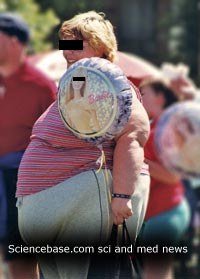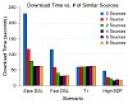 UPDATE: OCT 15, 2008 – Investigations at CERN* following a large helium leak into sector 3-4 of the Large Hadron Collider (LHC) tunnel have confirmed that cause of the incident was a faulty electrical connection between two of the accelerator’s magnets. This resulted in mechanical damage and release of helium from the magnet cold mass into the tunnel.
UPDATE: OCT 15, 2008 – Investigations at CERN* following a large helium leak into sector 3-4 of the Large Hadron Collider (LHC) tunnel have confirmed that cause of the incident was a faulty electrical connection between two of the accelerator’s magnets. This resulted in mechanical damage and release of helium from the magnet cold mass into the tunnel.
Proper safety procedures were in force, the safety systems performed as expected, and no one was put at risk. Sufficient spare components are in hand to ensure that the LHC is able to restart in 2009, and measures to prevent a similar incident in the future are being put in place.
‘This incident was unforeseen,’ said CERN Director General Robert Aymar, ‘but I am now confident that we can make the necessary repairs, ensure that a similar incident can not happen in the future and move forward to achieving our research objectives.’
UPDATE: SEPT 10, 2008 – The first particle beam has been sent around the 27km long tunnel at the LHC. This is the equivalent of a computer POST (power on, self test), they are yet to collide any hadrons at near light speed (that will be the BOOT proper). Sciencebase has now published its Large Hadron Collider LHC-FAQ and will keep you up to date with the latest from the LHC via the site’s RSS newsfeed; subscribe for free now to stay informed, alternatively, you can get updates by email. For concerns about black holes and revelations at the Large Hadron Collider, you may wish to read an extended guest post on the subject.
Physics followers among our readers will have no doubt seen the ubiquitous LHC “typo” a million times, so we’ve been very careful to avoid it in this item (email me if you cannot work out what it is). But, one thing that is not unavoidable, is the huge number of news reports that claim there was some kind of mathematical error that led to the recent little big bang at the CERN site.
Jonathan Leake at The Times, for instance, in an article headlined: “Big Bang at the atomic lab after scientists get their maths wrong” says, “A £2 billion project to answer some of the biggest mysteries of the universe has been delayed by months after scientists building it made basic errors in their mathematical calculations.”
Tests were started on the enormous magnets that will pull particles around the accelerator to great speeds in a giant experiment to mimic conditions at the beginning of time. But, I just heard from Fermilab visiting scientist Peter Limon, who is helping to commission the LHC, and he tells an entirely different story. What exactly was the cause of the accident deep underground at the CERN particle accelerator complex near Geneva in Switzerland?
“The problem with the inner triplet magnets in the LHC is as follows,” Limon told me, “The superconducting magnets themselves are in a pressure vessel (called the cold mass) that will eventually be cooled to 1.9 K for operation. These cold masses are suspended inside a cryostat (a vacuum vessel) so that they can be isolated from the heat that would otherwise make it impossible to cool the magnet. The suspension is made of a composite glass/epoxy material to minimize the heat flow from the outside of the vessel into the magnet.”
Some reports have claimed that the magnet was lifted out of its mountings. “The magnets did not lift itself off its mountings,” Limon said emphatically, “The break was in suspension pieces inside the cryostat. There was no motion of the magnet on its mountings, as far as we can tell.”
Limon then explained that, “Because of the geometry and the connections between magnets in the inner triplet, there is an unbalanced longitudinal force on the cold mass when the cold mass is pressurized.” This force, he adds, is transmitted from the cold mass to the the cryostat through the composite suspensions. “The design of the suspensions is inadequate to withstand those forces, but at 20 atmospheres, they broke,” he says, “The pressure test would have been successful if the pressure had gotten to 25 atm.”
Engineering calculations completed independently by Fermilab and CERN on March 28, the day after the accident, showed that the G-11 support structure in the magnets was inadequate to withstand the associated longitudinal forces. The word “inadequate” is rather euphemistic in this context, in reality the equipment simply was not up to the job in hand and it broke under the strain.
“In short,” Limon told me, “this was not a mathematical error, but an engineering omission. The full extent of the unbalanced longitudinal force (as much as 15 tons!) was not taken into account when the suspension was designed.”
I don’t believe design sabotage has been ruled out, but it is rather unlikely. Although the cynical among us will note that Fermilab who designed the magnet is also a scientific rival of CERN itself. Fermilab operates a particle accelerator, Tevatron, that is less powerful than the LHC but which Fermilab scientists are continually pushing to its limits. Moreover, they hope to beat CERN in the race to find the key particle that could unlock the secrets of the universe – the Higgs boson – before the LHC is even fired up.
The repair work by Fermilab and CERN staff, is according to the CERN website “being closely coordinated”. Fermilab personnel are on site at CERN, no doubt working under a cloud. That phrase “closely coordinated” would suggest some serious monitoring of activities. Too right.
Additionally, Fermilab is currently examining all aspects of the US-supplied components for the LHC just in case there are any other “potential vulnerabilities.” Whether CERN’s problems were mathematical or engineering in origin, CERN’s plans have been seriously delayed, which could give the Tevatron, with its dearth of “potential vulnerabilities” a particular advantage in the quest for the secrets of the universe.
NEWS FLASH
On Thursday 26 April, the last superconducting magnet of the Large Hadron Collider (LHC), a 15 metre long dipole weighing 34 tonnes, will be lowered in to the 27 km tunnel of the accelerator. With this magnet, the world’s largest superconducting installation receives its final component. The LHC is made up of some 1700 superconducting magnet assemblies, which will guide and focus the LHC’s particle beams. Teams are at work in the tunnel to conclude the complex task of magnet interconnection, and the sequence of procedures necessary before the machine’s scheduled start-up at the end of the year.
Coming soon: The Large Hadron Collider FAQ (the LHCFAQ) from Sciencebase.
The discovery of the life-threatening effects of Vioxx led to its rapid withdrawal by manufacturer Merck under pressure from drug agencies. Now, the successor to the notorious osteoarthritis drug, Arcoxia, is to be banned by the Food and Drug Administration.
 Could the claims of the “organic” farming movement be true after all? According to an international team who have analysed the antioxidant, mineral, and nitrate composition of kiwifruit, yes. Their findings published in the Journal of the Science of Food and Agriculture would suggest that growing the fuzzy green fruit using so-called organic principles leads to a higher content of health-promoting factors than those grown using conventional methods.
Could the claims of the “organic” farming movement be true after all? According to an international team who have analysed the antioxidant, mineral, and nitrate composition of kiwifruit, yes. Their findings published in the Journal of the Science of Food and Agriculture would suggest that growing the fuzzy green fruit using so-called organic principles leads to a higher content of health-promoting factors than those grown using conventional methods. UPDATE: OCT 15, 2008 – Investigations at CERN* following a large helium leak into sector 3-4 of the Large Hadron Collider (LHC) tunnel have confirmed that cause of the incident was a faulty electrical connection between two of the accelerator’s magnets. This resulted in mechanical damage and release of helium from the magnet cold mass into the tunnel.
UPDATE: OCT 15, 2008 – Investigations at CERN* following a large helium leak into sector 3-4 of the Large Hadron Collider (LHC) tunnel have confirmed that cause of the incident was a faulty electrical connection between two of the accelerator’s magnets. This resulted in mechanical damage and release of helium from the magnet cold mass into the tunnel. What connects cooling computer chips, melting car engines, and a balloon that will not pop? This week’s science video sees Robert Krampf explaining the principles behind heat sinks, car radiators, water cooling, and how to hold a balloon above a burning candle without it ever popping.
What connects cooling computer chips, melting car engines, and a balloon that will not pop? This week’s science video sees Robert Krampf explaining the principles behind heat sinks, car radiators, water cooling, and how to hold a balloon above a burning candle without it ever popping. Today’s claims in the media about the recently discovered obesity gene are at best overwrought and at worst downright dangerous. A vast study involving more than twenty research centres across the UK has allegedly demonstrated that almost one fifth of us carry a variant of the gene known as FTO that predisposes us to obesity or overweight.
Today’s claims in the media about the recently discovered obesity gene are at best overwrought and at worst downright dangerous. A vast study involving more than twenty research centres across the UK has allegedly demonstrated that almost one fifth of us carry a variant of the gene known as FTO that predisposes us to obesity or overweight. The latest issue of Intute Spotlight from David Bradley and the physical sciences portal is now online:
The latest issue of Intute Spotlight from David Bradley and the physical sciences portal is now online: Anyone who has dared to download, a large file using the Bit Torrent system in which chunks of the file are pulled from other BT users in a form of distributed file sharing will know how slow (and sometimes how fast) the method can be. Although much of the BT system is exploited to share pirated movies and music it has a serious, legitimate side that also allows scientists, engineers and programmers to share the burden of huge database and ISO image downloads. Now, thousands of US tax dollars (in the form of an NSF CAREER grant) have been spent on improving on the Bit Torrent system.
Anyone who has dared to download, a large file using the Bit Torrent system in which chunks of the file are pulled from other BT users in a form of distributed file sharing will know how slow (and sometimes how fast) the method can be. Although much of the BT system is exploited to share pirated movies and music it has a serious, legitimate side that also allows scientists, engineers and programmers to share the burden of huge database and ISO image downloads. Now, thousands of US tax dollars (in the form of an NSF CAREER grant) have been spent on improving on the Bit Torrent system.